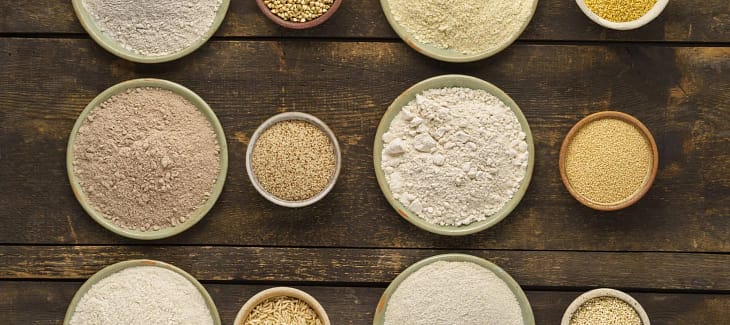Are you getting tired of using the same old flour to bake or cook your food with? With so many different flour substitutes out there, it can be difficult to choose which one will work best for you. Many breakfast recipes change drastically depending on the type of flour you use. These changes include differences in taste, texture, consistency, density, and shelf life. Clearly, it is important to understand how these different types of flours will affect your favorite breakfast meal.
Experimenting with multiple flour substitutes can be a good idea because no two flour types are the same. While everyone usually defaults to all-purpose (AP) flour to make their breakfast foods with, it is usually one of the least healthy types of flour you can use. AP flour is starchy, fatty, and rough for your gut health (although it is great at binding dough and batters together).
This article is perfect if you are concerned about your health and want to improve the quality of your morning breakfast. Take a look at these ten flour substitutes and choose the ones that work best in your diet.
Almond flour

Almond flour may be the most common nut flour substitute in baking recipes. This is thanks to its reliability, ubiquity in grocery stores, and similar texture to AP flour. Even though it is a little on the pricey side, this flour works great in almost any baking recipe.
Compared to AP flour, almond flour is rich in nutrients and is naturally gluten-free. It contains tons of vitamin E, which is good for your heart, lung, and immune health. Plus, it has certain antioxidants that help your skin stay heathy and reduce the risk of serious inflammatory infections. Copper, manganese, phosphorus, calcium, iron, and protein make up a lot of the nutrition in almond flour as well.
Any breakfast recipe can use almond flour, thanks to its versatility. Many internet recipes will show you creative ways to use this gluten-free nut flour. Try using it in healthy cookie recipes, as well as waffles, pancakes, biscuits, and breakfast bread. For more information on almond flour in particular, this article directly compares this popular nut flour to traditional AP flour.
Cassava flour

This gluten-free flour contains plenty of nutrients and is also paleo-friendly. It looks, feels, and tastes similar to white flour, and works well for both sweet and savory recipes.
Because this flour is so dense and nutty, you should never substitute it for white/AP flour in a 1:1 ratio. For every 1 cup of regular flour, use ¾ cup of cassava flour. Like almond flour, it works nicely in any baking recipe.
Cassava flour possesses a moderate amount of calories, no cholesterol, little fat, and a decent chunk of fiber and protein. Cassava is not recommended for keto users since its carbohydrate content is similar to AP flour.
Coconut flour

Coconut flour derives its base from ground coconut and tastes mild and sweet. Most importantly, this flour is naturally gluten-free, nut free, and grain-free. This flour really shines when it is combined with foods that complement its flavor, such as bananas, chocolate, and cinnamon. For every 1 cup of white flour, use a fourth of a cup or third of a cup of coconut flour.
Like almond flour, coconut flour is great for keto users thanks to its low sugar and carbohydrate content. Nutritionally, it contains more fat and oil than other flours. This makes it easier to mix with other ingredients in baking recipes, but also gives it a slightly shorter shelf life than other flours. Coconut flour is low on the glycemic index and has a healthy amount of fiber and protein.
For beginners, it is best to start out with recipes made specifically for coconut flour like this recipe for coconut flour cookies. Admittedly, it is one of the harder flour substitutes to use because it has a different texture and density than white flour. Overall, it is an excellent and nutritious flour substitute for anyone to have.
Amaranth flour

Amaranth is a healthy ancient grain originally cultivated by the Incas, Mayas, and Aztecs, dating as far back as eight thousand years ago. By itself, amaranth tastes nutty and crunchy, and can work well as a cereal. It looks and feels a lot like steel-cut oats.
Amaranth flour is naturally gluten-free and is one of the healthiest and underrated flour substitutes you can find. The best part about this flour is that has plenty of fiber, vitamins, and minerals, and unlike other grains, it also contains all 9 essential amino acids that your body cannot produce on its own, making it a complete protein. Additionally, it is rich in antioxidants, good for balancing cholesterol levels and blood pressure, and helps aid digestion.
For every 1 cup of AP flour, use ¼ of a cup of amaranth flour in your recipes. Traditionally, amaranth flour is great for making flatbreads, tortillas, and chapati, thanks to its texture and nutrient-rich makeup. However, it also works well for muffins, cookies, and biscuits. Be aware that this flour absorbs liquids which may dry up certain foods, so you may need more water and milk in your amaranth flour baking recipes.
Buckwheat flour

Buckwheat is an Asian plant that produces starchy seeds, which get milled into a tasty and nutritious flour. Like amaranth flour, buckwheat flour has a coarse texture and a bold, nutty taste.
Compared to other flour substitutes, buckwheat flour is very rich in magnesium and copper, both of which are sorely lacking in most people’s diets. Buckwheat flour really shines in pancake recipes, as well crepe, blini, and shortbread recipes.
Oat flour

Oat flour is one of the easiest flours you can make from scratch, as it only requires you to mix rolled oats in a blender. This flour is nothing more than a whole-grain flour made from milled rolled oats. It is perfect for those looking to incorporate the health benefits of oats into any baking recipe. By using oat flour instead of individual oat clusters in baking recipes, you can reap more nutrients from the oats since the density of oats in your recipe will be higher.
Rolled and steel-cut oats are known to have many nutritional benefits. They have some of the highest concentrations of vitamins and minerals of any grain, as well as being high in soluble fiber. Oats do a great job at staving off hunger and helping to digest hard foods, making them great for weight loss.
Oat flour works best in pancake, muffin, cake, cookie, and bread recipes since it has a dense texture and mild, slightly sweet flavor.
Whole wheat flour

If you don’t mind gluten in your flour and you also want a flour that has an easy replacement ratio to regular flour, whole wheat flour is your friend. Whole wheat is much healthier than refined wheat because it has a much higher concentration of fiber over simple carbohydrates.
The taste of whole wheat can be a little off-putting to those who prefer the taste of AP flour, so it may help to add flavor sweeteners in your baking recipes such as chocolate chips and fruit purees. Whole wheat flour works well in any breakfast baking recipe, but it really shines in bread recipes such as pizza and pasta.
Fiber is a critical macronutrient in breakfast foods, and whole wheat has the one of the highest concentrations of fiber out of all flour substitutes on this list.
Chickpea flour

Popular in Indian cuisine, this flour substitute is becoming more well-known in the West as an alternative to wheat flour. Chickpea flour can be made from many legume bases and it is a bit complicated to make, but the type of chickpea flour I am covering in this article is made from ground garbanzo beans.
Chickpea flour is high in protein and fiber, making it effective at satisfying your hunger. One of the most versatile flour substitutes, chickpea flour can be used in breakfast recipes as well as dinner recipes and large family meals.
It works great for making flatbread from scratch and batter-based foods such as pancakes and waffles. You can either make this flour at home with ground garbanzo beans or buy it premade at the grocery store for a very cheap price.
White/Brown Rice flour

This is a more common flour alternative in Japan and India, although it is gaining popularity in the Americas as well. Grocery stores will commonly sell white rice flour, but brown rice flour may also sit near it in most cases. There isn’t much difference between white and brown rice flour, except for slight variations in nutrient content.
Rice flour has a good amount of fiber and helps promote healthy liver function. However, that’s all it has going for it-it probably has the least amount of vitamins, minerals, and protein of any flour substitute on this list. Because of this, many bakers opt to combine this flour with other protein-rich flours like buckwheat. They may also integrate small protein-dense foods like egg whites and protein powder into the flour.
Its role in baking is almost exactly opposite from gluten-free AP flour. This is because even though it lacks gluten, it is excellent as a bonding agent and it prevents liquid separation. This can be especially useful when baking more complex foods like cake, crackers, and dumplings. Rice flour’s stickiness and ease of use earns it a spot on this list as a great all-around flour substitute.
Gluten-free AP flour
Finally, you can go with the easiest flour substitute of all, which is any all-purpose flour that has its gluten content completely removed. It’s perfect if you want to make an AP flour recipe, but you either have gluten intolerance or gluten allergies.
Keep in mind that gluten acts as a binder of sorts, gluing food together and giving it a stretchy quality. With that in mind, this flour may make homemade pizzas and pancakes a little harder to make, and you must be sure that your recipes contain enough liquid so you can prevent any dough from breaking apart. Because of this, making bread from scratch with gluten-free AP flour is not recommended.






